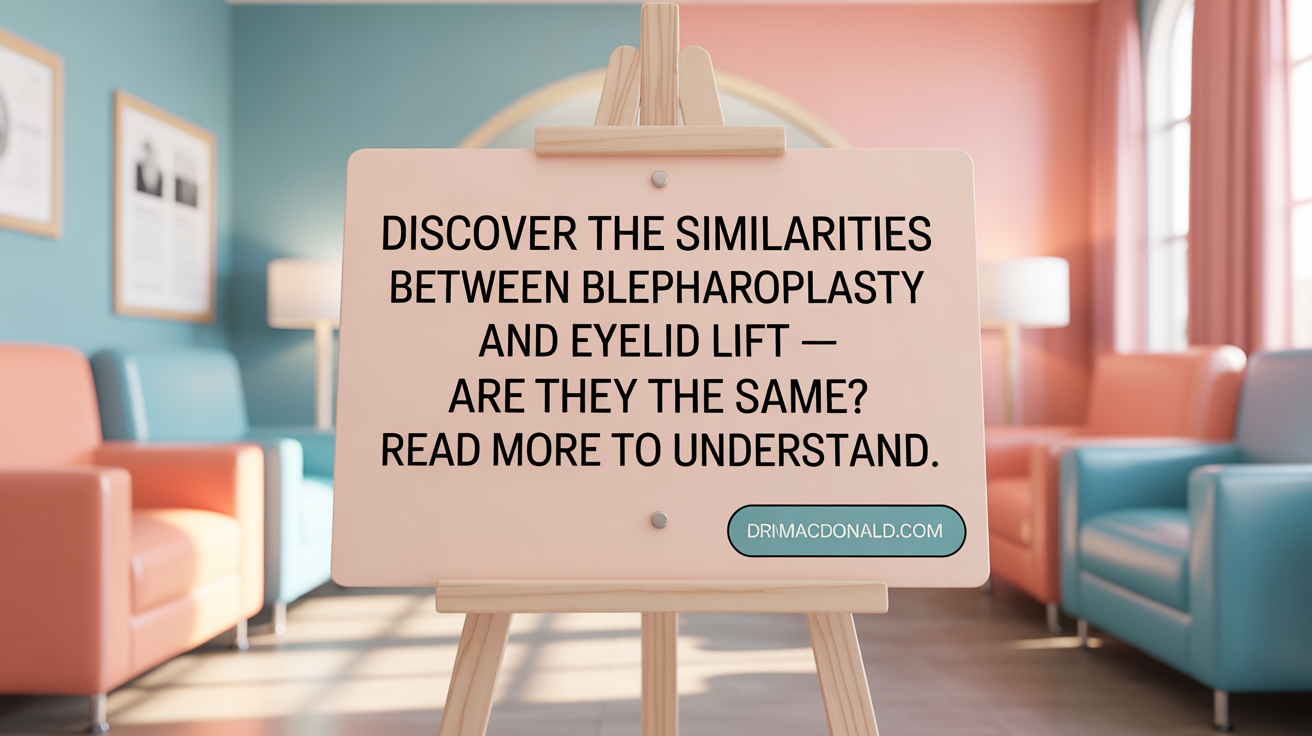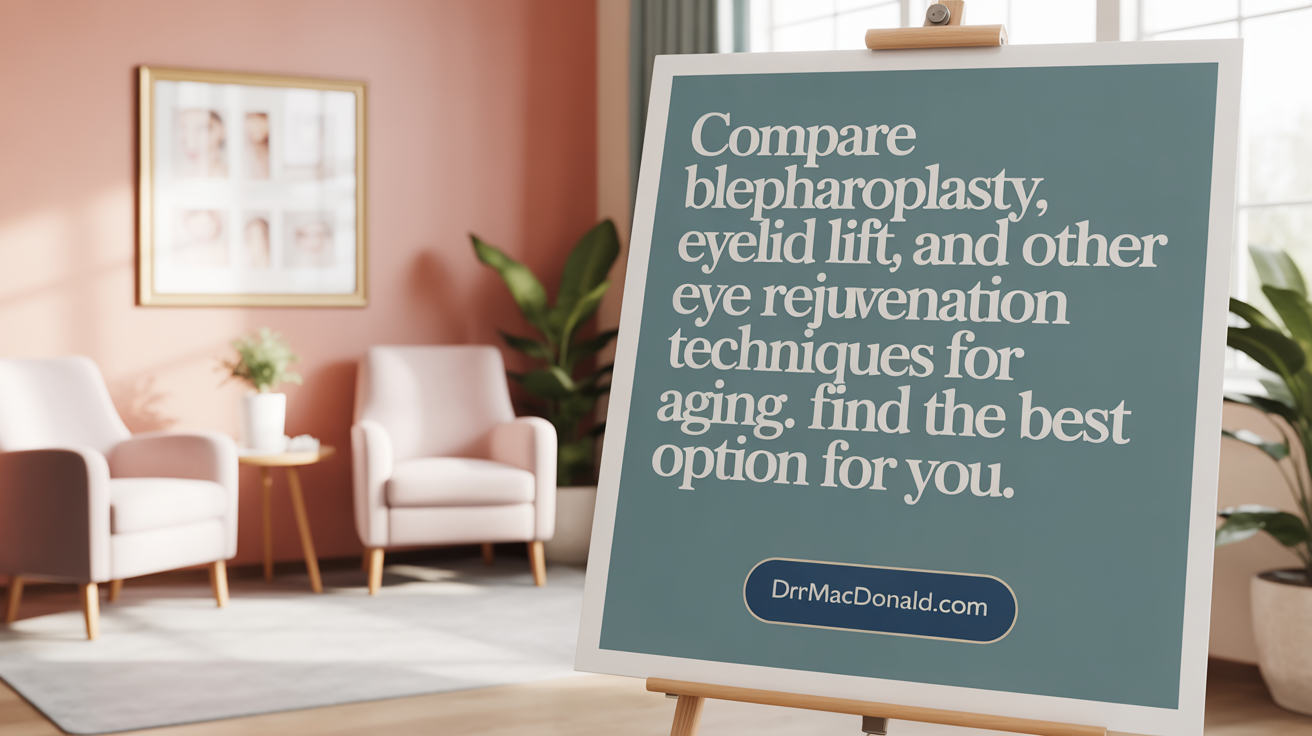Introduction to Blepharoplasty and Eyelid Lift
Blepharoplasty and eyelid lifts are often terms used interchangeably, yet subtle distinctions and nuances exist in their definitions, purposes, and applications. Both procedures serve to combat the signs of aging around the eyes by addressing excess skin, fat, and tissue. This guide aims to clarify these treatments, highlighting their similarities, differences, and appropriate uses to empower readers in making informed choices about eye rejuvenation.
Eyelid and Eye Rejuvenation Procedures - Key Facts
- Blepharoplasty is a surgical procedure that removes excess skin, fat, and muscle to tighten the upper eyelids.
- Blepharoplasty and an eyelid lift are interchangeable terms for the same procedure focused on eyelid rejuvenation.
- The primary purpose of blepharoplasty is to improve aesthetic appearance and functional vision by correcting drooping eyelids.
- Differences between blepharoplasty and brow lift involve the target areas: eyelids versus eyebrows and forehead.
- Blepharoplasty typically lasts over 10 years or a lifetime, offering long-lasting aesthetic and functional results.
- Recovery from eyelid surgeries involves swelling, bruising, and most patients resume activities within 1-2 weeks.
- Less invasive options, like thread lifts, provide temporary effects lasting 6 months to 2 years with shorter recovery.
- Combining procedures such as blepharoplasty and brow lift can address multiple facial concerns for comprehensive rejuvenation.
- Making an informed decision involves consulting with qualified surgeons, understanding options, and setting realistic expectations.
- Individual factors like eye health, insurance coverage, and personal goals influence the choice of appropriate treatment.
1. Blepharoplasty vs Eyelid Lift: Are They the Same Procedure?

What is blepharoplasty, and how does it help tighten the upper eyelids?
Blepharoplasty is a surgical procedure that involves removing excess skin, muscle, and fat from the upper eyelids to improve their appearance and function. It helps tighten the upper eyelids by creating incisions along the natural folds of the eyelids, trimming sagging tissue, and suturing the remaining skin and tissue to create a smoother, firmer eyelid. This process can restore a more youthful and alert look, making the eyes appear brighter and less tired.
In addition to aesthetic benefits, blepharoplasty can improve vision obstructed by heavy, drooping eyelids. The surgery is especially beneficial for patients experiencing functional issues due to eyelid sagging. Typically performed on an outpatient basis under local or general anesthesia, the procedure lasts about 45 minutes to two hours.
Recovery involves managing swelling, bruising, and protecting the eyes during healing. Most patients notice significant improvement within a week, with final results lasting for many years. Hence, blepharoplasty offers both cosmetic rejuvenation and functional enhancement, helping patients look refreshed and see better.
Is blepharoplasty the same as an eyelid lift?
Yes, blepharoplasty is the medical term for what is commonly called an eyelid lift. The terms are interchangeable and refer to the same surgical procedure. An eyelid lift specifically involves removing excess skin, fat, and sometimes muscle from the upper and lower eyelids to correct drooping, puffiness, and wrinkles.
Many people use the phrase 'eyelid lift' to describe this procedure because it captures the goal of lifting and tightening the eyelid area. Blepharoplasty can be performed solely for cosmetic reasons—to create a more youthful and alert appearance—or for functional reasons, such as restoring vision when eyelids droop significantly.
The procedure is highly popular, with over 100,000 performed annually in the United States alone. It can be done under local anesthesia with sedation and typically takes less than two hours. Patients are advised to consult with a qualified, board-certified surgeon to determine the best approach for their specific needs and ensure safe, effective results.
2. Comparing Blepharoplasty and Eyelid Lift with Other Eye Rejuvenation Techniques

How do blepharoplasty, eyelid lift, and brow lift surgeries differ in purpose and technique?
Blepharoplasty, commonly called an eyelid lift, is a surgical procedure focusing on removing excess skin, fat, and muscle from the eyelids to improve their shape and youthful appearance. It can target the upper eyelids for drooping or hooded skin or the lower eyelids to reduce under-eye bags and puffiness. The technique usually involves small incisions along natural folds or lashes, followed by tissue removal and tightening.
In contrast, a brow lift addresses sagging eyebrows and forehead wrinkles. It lifts the brow region via incisions either behind the hairline, within forehead creases, or at the temples, to elevate the brows and smooth forehead skin. While blepharoplasty enhances the eyelids specifically, brow lifts aim at raising the eyebrows for a more open-eyed look.
Both surgeries may be combined for comprehensive facial rejuvenation. The primary distinction lies in their target areas and technical approaches: eyelid surgery refines the eyelids themselves, while brow lifts manipulate the forehead and brow region.
What are the differences between blepharoplasty and ptosis repair procedures?
Blepharoplasty involves removing excess skin, fat, and muscle from the eyelids, primarily addressing aesthetic concerns such as sagging, puffiness, and wrinkles. This procedure can also improve vision if droopy eyelid skin obstructs sight. It typically involves making small incisions in the natural eyelid creases or below the lashes, followed by tissue reshaping.
Ptosis repair, however, is a functional procedure aimed at correcting drooping eyelids caused by dysfunction of the eyelid muscles, particularly the levator muscle. This condition, known as ptosis, can impair vision and is often congenital or age-related. The technique usually involves tightening or reattaching the levator muscle to elevate the eyelid.
While blepharoplasty is mainly cosmetic with functional benefits, ptosis repair primarily restores eyelid function but can also enhance appearance. The two procedures can be combined if a patient has both excess tissue and eyelid drooping, offering both aesthetic and functional improvements.
How do techniques and surgical approaches vary?
Different surgical techniques cater to the specific needs of each procedure. Blepharoplasty on the upper lids often involves an incision along the eyelid crease to remove excess skin and fat, creating a natural and subtle scar. Lower eyelid procedures may involve an incision on the outer eyelid edge or inside the eyelid to reposition or remove fat.
Brow lifts use various approaches, such as endoscopic methods with small scalp incisions, or traditional techniques with direct incisions along the hairline or forehead. These surgeries can be tailored to lift the brow effectively while minimizing visible scars.
What are the recovery processes and outcomes?
Recovery from eyelid surgeries generally lasts about 7-14 days, with swelling and bruising resolving within that period. Patients typically wear cool compresses, use prescribed eye drops, and avoid strenuous activities. The results become visible quickly, with a more alert and youthful appearance lasting many years, often over a decade.
Brow lift recovery is similar, with initial swelling and bruising in the forehead area resolving in about 7-10 days. Full healing and final results may take a few months. Both procedures aim for natural, expressive results without a surprised or angry look.
How long do results last?
The longevity of eyelid surgery varies. Upper blepharoplasty results can last over 10 years or a lifetime, while lower eyelid improvements tend to be durable but may require touch-ups over time. Brow lift effects typically last several years, with ongoing aging processes gradually influencing results.
What are the risks and benefits?
Risks include swelling, bruising, infection, scarring, dry eyes, difficulty closing the eyes, or nerve damage. Serious complications are rare but can involve vision issues or anesthesia risks.
Benefits entail a more refreshed and youthful appearance, improved eyelid function, and enhanced self-confidence. Combining procedures can maximize aesthetic and functional results.
When should one consider combining with a brow lift or non-surgical treatments?
Patients with both drooping brows and eyelid sagging often benefit from combination surgeries. A brow lift elevates low eyebrows and smooths forehead lines, complementing blepharoplasty’s eye-specific improvements.
Non-surgical options such as Botox, fillers, laser treatments, or skin tightening can also enhance the results or delay the need for surgery, especially in younger patients or those seeking minor corrections.
This comprehensive approach ensures that individual facial features and aging patterns are addressed holistically, resulting in a natural and harmonious rejuvenation.
Recovery Process and Expected Outcomes of Blepharoplasty and Brow Lift

What are the typical recovery processes and outcomes for blepharoplasty and brow lift surgeries?
Recovery after both blepharoplasty and brow lift surgeries generally involves an initial period of swelling and bruising. These symptoms often last from several days up to two weeks, gradually improving with time. Patients are encouraged to rest, keep their head elevated, and apply cold compresses regularly to minimize swelling and discomfort.
Most patients can resume light activities within a week or two. It's advisable to avoid strenuous exercises, heavy lifting, and strenuous physical activities for at least several weeks post-surgery. Sutures, if non-absorbable, are generally removed within the first week. The majority of individuals return to work during this period, especially if their job does not involve physical strain.
Full healing and final results may take up to six months. During this time, scars fade significantly, contributing to a more natural and youthful appearance. The outcomes usually include lifted brows, smoother forehead lines, and refined eyelid contours. The eyes look more alert, with a refreshed appearance that often boosts confidence.
Both procedures tend to offer long-lasting results. However, natural aging, lifestyle choices, and skin health can affect how long the benefits last. Maintaining a healthy routine and protecting the skin from sun exposure can help prolong the youthful results achieved through surgery.
Adherence to postoperative care instructions is essential to prevent complications and support optimal healing. Regular follow-ups with the surgeon ensure that healing progresses as expected and address any concerns promptly.
In summary, while the initial recovery spans about one to two weeks, the full benefits of blepharoplasty and brow lift are appreciated over several months, resulting in a rejuvenated upper face and eye area that can last many years.
Comparing Benefits, Risks, and Longevity of Blepharoplasty vs Less Invasive Eyelid Lifts
How do the benefits, risks, and longevity compare between blepharoplasty and less invasive procedures like thread lifts?
Blepharoplasty is a surgical procedure that aims for dramatic and lasting results by removing excess skin, fat, and sometimes muscle from the eyelids. Since it involves precise tissue removal and tightening, it often produces a more significant rejuvenation effect. Typically, its results can last many years—often a lifetime for upper eyelids—although the natural aging process continues afterward.
However, being an invasive surgery, blepharoplasty carries certain risks. These include scarring, bleeding, infection, dry or irritated eyes, and potential difficulty closing the eyes. Rare complications like vision problems or nerve damage are also possible. Recovery time usually spans 1 to 2 weeks, with swelling and bruising subsiding within this period.
In contrast, less invasive options such as thread lifts involve inserting absorbable sutures to lift and tighten the skin—usually without incisions or general anesthesia. Results are more subtle and temporary, generally lasting from six months to two years, depending on the individual and the technique used.
Thread lifts boast shorter recovery times and less discomfort, often with minimal downtime. They are an attractive choice for patients seeking minor improvements without the risks associated with surgery. However, because the effects are temporary, repeat treatments are typically necessary to maintain the results.
In summary, blepharoplasty provides a more durable, long-lasting correction suitable for more pronounced eyelid concerns. Less invasive methods like thread lifts offer a quick, lower-risk option for mild aging signs but with effects that fade over time. The best choice depends on patient needs, desired results, and overall health, which should be discussed thoroughly with a qualified facial surgeon.
Making an Informed Decision about Eyelid and Eye Rejuvenation Options

How can a person make an informed decision regarding eyelid and eye rejuvenation options?
Choosing the right eyelid or eye rejuvenation procedure requires careful consideration and research. Patients should start by understanding the different options available, such as blepharoplasty, brow lift, and functional eyelid surgeries. Each procedure targets specific issues: blepharoplasty primarily addresses excess skin, fat, and tissue to improve appearance, while brow lifts focus on elevating drooping eyebrows and smoothing forehead wrinkles.
Consulting with a qualified, board-certified surgeon is crucial. A professional can assess individual anatomy, eye health, and specific concerns, like drooping eyelids obstructing vision or under-eye puffiness. During consultation, reviewing before-and-after photos of previous patients helps in setting realistic expectations about results.
Understanding the risks, recovery times, and longevity of each procedure informs better decision-making. For instance, blepharoplasty generally offers long-lasting results but may require touch-ups over time due to aging. Considering whether functional issues like visual impairment are involved can influence the choice—some surgeries are deemed medically necessary and may be covered by insurance.
Cost is another important factor. Procedures like blepharoplasty can vary in price depending on clinic location and complexity, with combined surgeries often costing more but providing comprehensive rejuvenation.
Balancing cosmetic desires with safety, eye health, and the surgeon’s expertise ensures an optimal outcome. Ultimately, combining thorough research, professional guidance, and clear communication about goals leads to well-informed surgery choices.
Choosing the Right Eyelid Rejuvenation Procedure
Understanding the nuances between blepharoplasty and eyelid lifts is crucial as these terms often converge but may imply subtle differences in context. Blepharoplasty is essentially the surgical eyelid lift, focusing on removing excess tissue for both cosmetic enhancement and functional improvement, particularly for vision. Eyelid lift can refer to this surgery or include less invasive treatments. Comparing these procedures with other options like brow lifts and ptosis repairs further aids in comprehending which treatment best addresses specific concerns. Recovery and risks vary, with surgery offering lasting and significant changes, while minimally invasive methods provide subtle enhancements with quicker downtime. Making an informed decision hinges on careful assessment, professional consultation, and realistic expectations to achieve rejuvenated eyes that harmonize both appearance and function.
References
- How are Blepharoplasty and Eyelid Surgery different? - SightMD
- Blepharoplasty vs. Brow Lift: Which To Get
- What is the Difference Between Ptosis Repair and Blepharoplasty?
- Blepharoplasty vs. Brow Lift: Which is Best for Sagging Eyelids?
- Nashville, TN - Eyelid Lift vs. Eyelid Surgery - TN Oculoplastics
- Eyelid Surgery Procedure Guide | ABCS
- Blepharoplasty, Eyelid Lift, and Brow Lift – What's the Difference?
- Blepharoplasty - Mayo Clinic
- Eyelid Surgery Vs. Brow Lift: Understanding the Key Differences | Blog
- Upper vs Lower Eyelid Blepharoplasty | Irvine, CA
